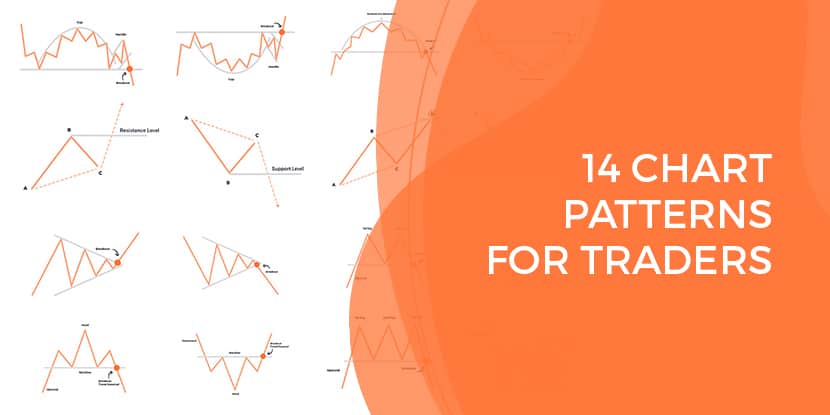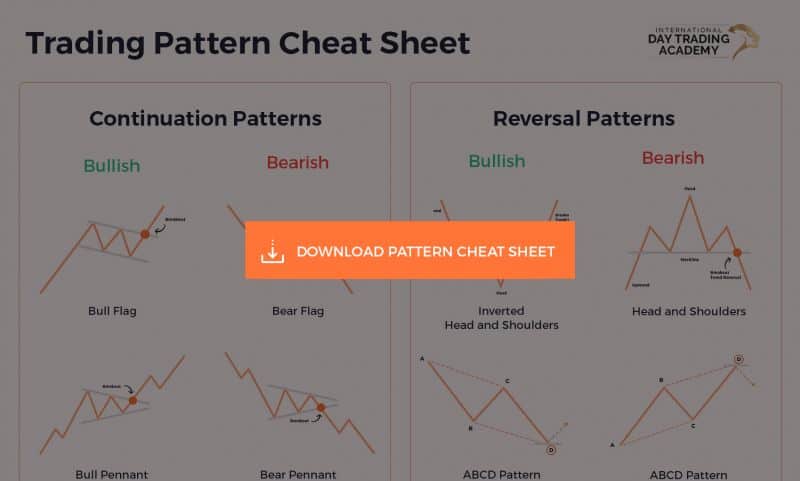Trading patterns are at the core of many decisions that day traders make. Most swing and day trading strategies take advantage of pattern movements. They can be the sign of a potentially profitable trade. In fact, this is how most traders find their trades. This is because, in most cases, price in financial markets generally repeat certain movements.
There are many popular trading chart patterns, in this article we’ll look at each of them and what they tell a trader. This article will discuss candlestick trading graph patterns for day trading, swing trading, and even long-term investing.
What Are Trading Patterns?
To understand what basic trading patterns are and how they form, you first need to know how to read candlestick charts. The most common form of chart used by day traders are candlestick charts. In this article I will use candlestick charts for all examples of basic trading graph patterns.
A trading chart provides information about the price of a given asset. A chart will show you the movement of price over time. Candlestick chart analysis will show where price opens, closes, and the high and low point it reached.
Trading patterns are a common shape or combination of lines formed when tracing price movements.
Why Does Candlestick Pattern Analysis Work?
There are two methods to picking a trade; fundamental analysis, and technical analysis. Fundamental analysis will create a hypothesis based on economic factors. Technical analysis will create a hypothesis based on trading chart data and sentiment. An example of this would be popular trading patterns.
So why does candlestick pattern analysis work to find potentially profitable trading patterns? Because many traders are looking for the same patterns. A long time ago, traders realised that patterns repeat with similar statistical properties. So in recognising these trading patterns, a trader can predict the more likely direction.
Price moves depending on whether there are more buyers than sellers, or more sellers than buyers. So if clean trading patterns form, there will likely be an increased interest in trading in a more probable direction. This tips the balance of buyers and sellers and the pattern fulfils its indicated direction more often than not.
Types of Basic Trading Patterns
Note, before we start: If the type of trading that you do only allows buying, half of the patterns discussed won’t be available to you. You will be able to take advantage of bullish day trading patterns, but not the bearish trading chart patterns.
This is one of the reasons why we trade futures, it allows us to buy and sell. Because of this we have trading opportunities when the market goes up and also when it goes down.
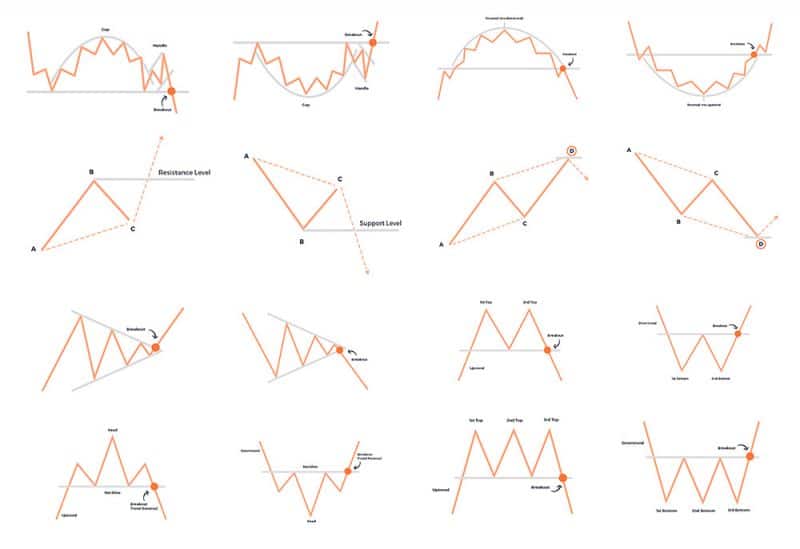
Continuation Trading Patterns
A continuation chart pattern suggests that price will continue in the same direction after a high or low completes. A common continuation are simple ‘trends’ which follow highs and or lows in one direction. Common continuation trading chart patterns can also include triangles, pennants, and flags.
Reversal Trading Patterns
Reversal trading patterns are the opposite of a continuation pattern. A reversal is the sudden change in direction of price. These reversals often happen when price reaches either support or resistance.
Trading patterns are a part of the creation of these support and resistance levels. You will find reversals in patterns like ABC patterns, channels, amongst others.
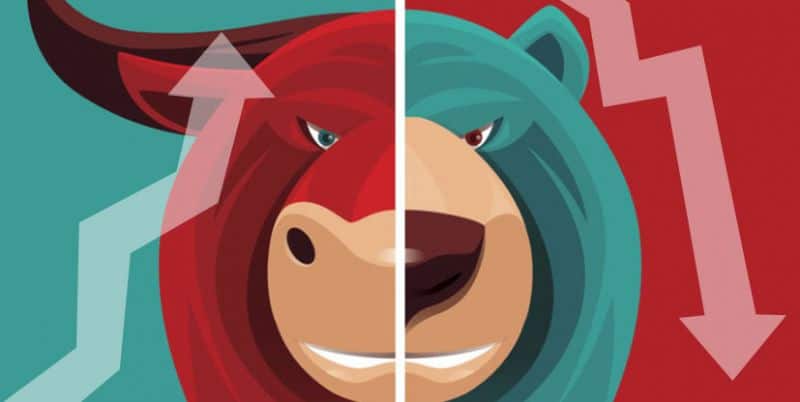
What are Bullish Trading Chart Patterns?
When a trader is “bullish” on an asset they have a strong belief that price will go up. The same is true for market sentiment overall. That said, a bullish pattern is one that indicates that price may go up.
This may be due to a continuation via breaking a resistance level, or a reversal off of support.
What are Bearish Trading Patterns?
When a trader is “bearish” on an asset they have a strong belief that price will go down. Again, the same is true for market sentiment overall. That said, a bearish pattern is one that indicates that price will may go down. The patterns are common in many bear market trading strategies.
This may be due to a continuation via breaking a support level, or a reversal off of a resistance level.
Breakout Trading Patterns
I have put these two patterns in their own category as they are not bullish or bearish. The trading patterns below (Sideways channel and Symmetric Triangle) have no direct sentiment in forming.
These trading graph patterns create well established support and resistance levels. Because of this the breakout could occur in either direction. Once price breaks a level it tends to see a big move. This is when the pattern becomes either bullish or bearish.
Sideways Channel Trading Patterns
A Sideways Channel is the simplest trading pattern to identify. These trading chart patterns form when a series of equal lows, and equal highs, create support and resistance levels.
A Sideways Channel is a consolidation indicating no strong market sentiment. The pattern will break when price breaches either support or resistance. This causes a breakout and price will trade at new levels.
Below is an example of price breaking resistance and forming a continuation to the high-side.
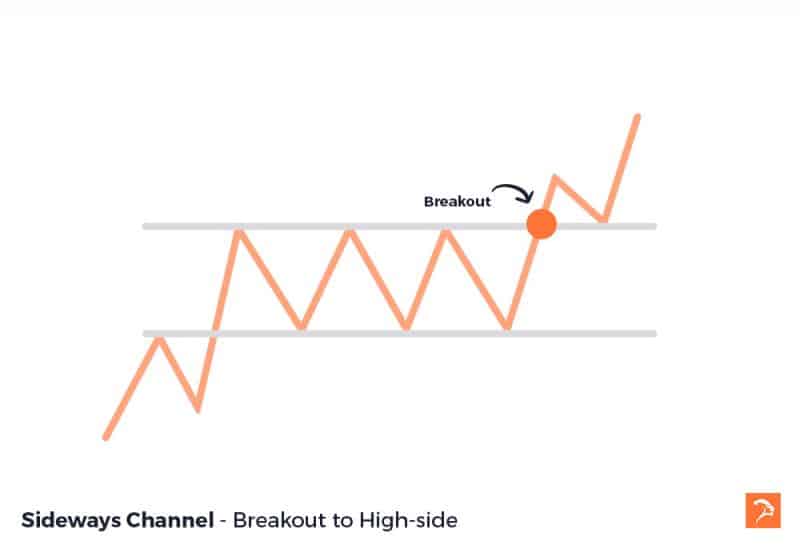
Below is an example of price breaking support and forming a continuation to the low-side.
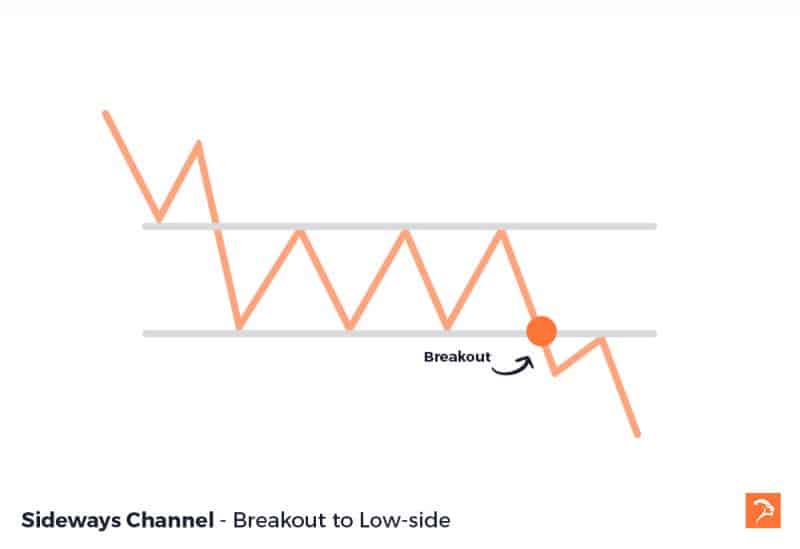
How to Trade Sideways Channel Trading Patterns
For larger channels look to buy or sell off of a support or resistance level. You should only be entering on a reversal, don’t trade into support or resistance. On a smaller channel you may choose to wait for price to break out of the channel as a continuation.
If trading the breakout, make sure you have confirmation of the breakout. Do this by waiting for the close of the first candle to break the support/resistance.
Real Life Example of a Sideways Channel Trading Pattern
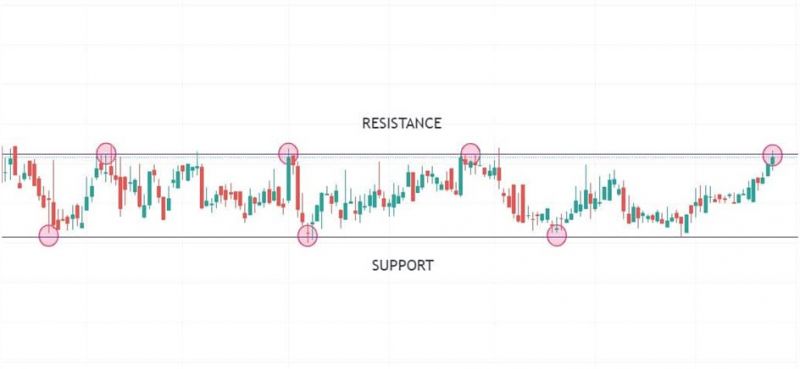
Symmetrical Triangle Trading Patterns
A Symmetrical Triangle is neither bullish nor bearish. These trading patterns form when a downtrend and an uptrend begin to reach a meeting point.
The support level consists of higher lows, with a trend line going up. The resistance level consists of lower highs, trending down. The two trend lines are of a similar angle and have an eventual meeting point.
As the trend lines begin to meet, the volume (number of trades) decreases. When the trend lines near a meeting point volume increases and creates a breakout.
If the triangle forms after a strong trend, that trend tends to break out into a continuation. An uptrend often breaks resistance and breaks to the high side, a downtrend breaks to the low side.
If the market is in a period of consolidation with no real direction, the triangle could break out in either direction. A trader will look to trade this pattern once it has confirmed a breakout.
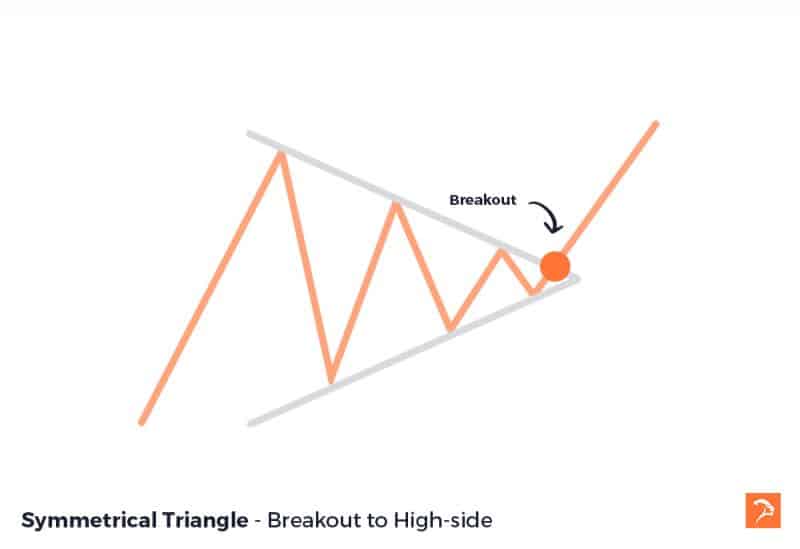
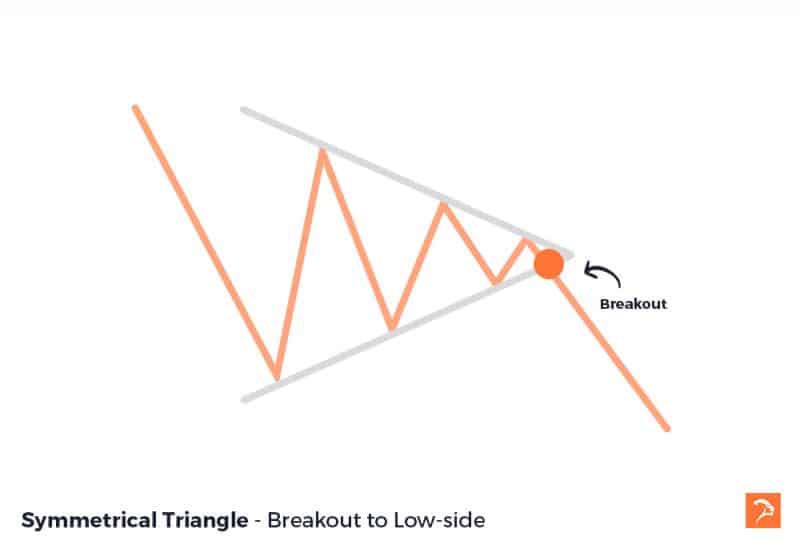
How to Trade Symmetrical Triangle Trading Patterns
These trading char patterns can break out to either the upside or downside. This means that a trader will need to wait for confirmation that a breakout has occurred. On the pattern below I would choose to put my stop loss just below the last point at which price reversed off of support. My target would be at the level where the triangle first forms which is about a 1:1 risk or better.
Real Life Example of a Symmetrical Triangle Trading Pattern
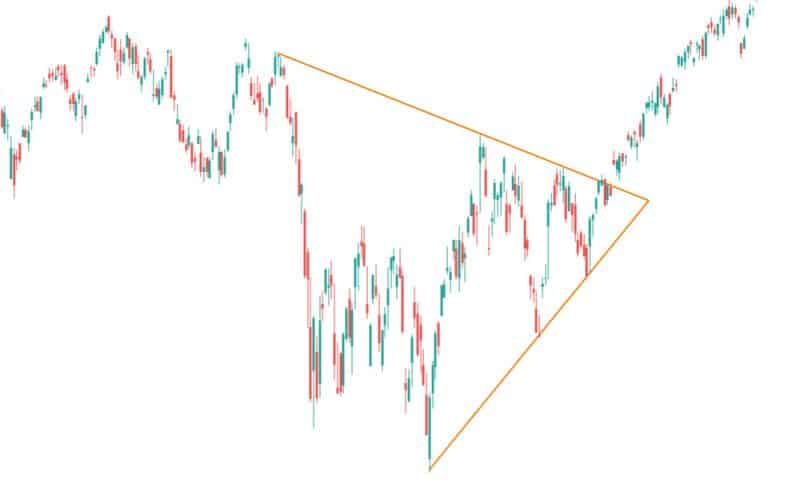
Bullish Trading Patterns
Ascending Channel Trading Patterns
Channels are another set of trading patterns that are easy to identify. An Ascending Channel is a type of continuation trading pattern. The overall sentiment is bullish and price forms higher highs and higher lows. These higher highs and higher lows create support and resistance levels.
While the pattern remains intact, these levels will see price reverse off of them.
When price reaches a support level, price is likely to move up. When price reaches a resistance level, price is likely to move down. What makes this pattern bullish is that each time a new high, or low forms it is at a higher price than the previous.
Note that there is also a bearish variant of this pattern which is discussed later in this article.
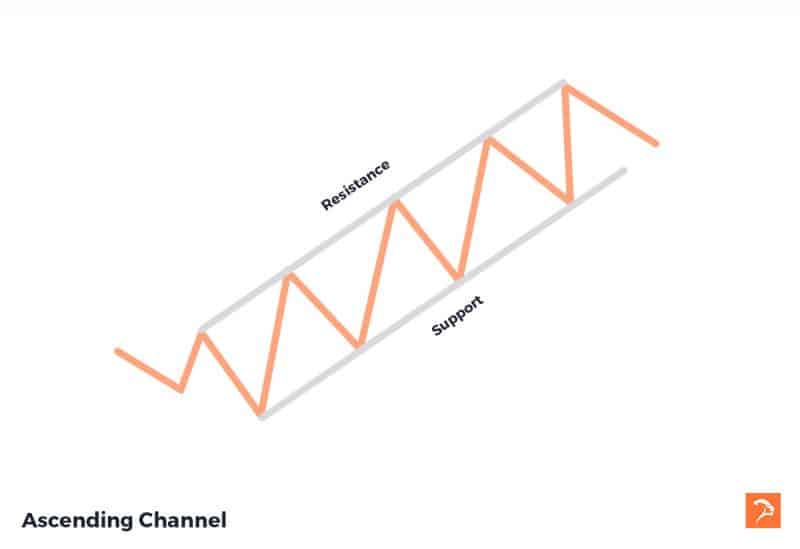
How to Trade Ascending Channel Trading Patterns
For an ascending channel a trader will look to enter off of a reversal of a support level. It’s important to not trade into support or resistance. You could choose to buy at the reversal off support and sell at resistance, or if you are confident, you could trade the trend up until support breaks.
Whatever you decide your profit target is, be sure that your stop is at least an equal distance from entry.
Real Life Example of an Ascending Channel Pattern
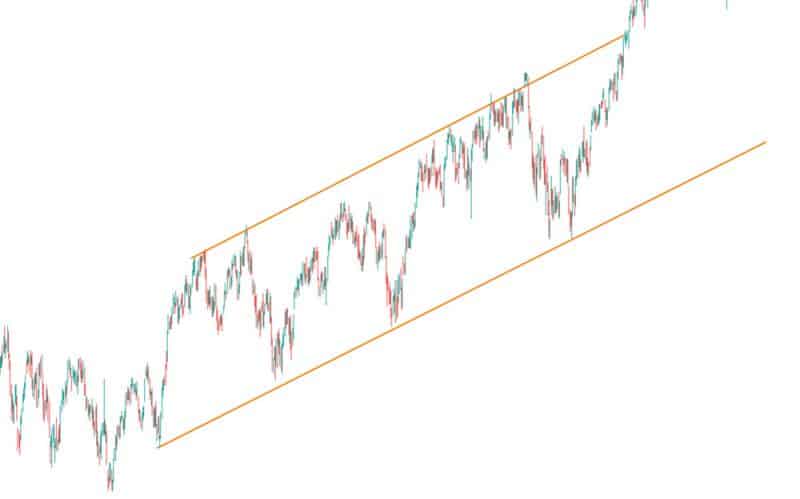
Ascending Triangle Trading Patterns
An Ascending Triangle is a pattern where an upward trend approaches a major horizontal resistance level. This resistance level is a price point that has proven difficult to break above.
An ascending triangle is an example of a continuation pattern. This trading pattern creates the upward trend as price reaches higher lows.
You can draw an ascending triangle using a horizontal line at the resistance level and trendline along the higher lows. The horizontal line along the highs is resistance, and the trend line along the lows is support.
The trading pattern has at least 2 highs at the same level, this forms the horizontal line. The more times price reverses off this resistance, the stronger the resistance is.
The higher lows form the trend line that completes the triangle. The closer that this trendline gets to resistance, the more likely the breakout.
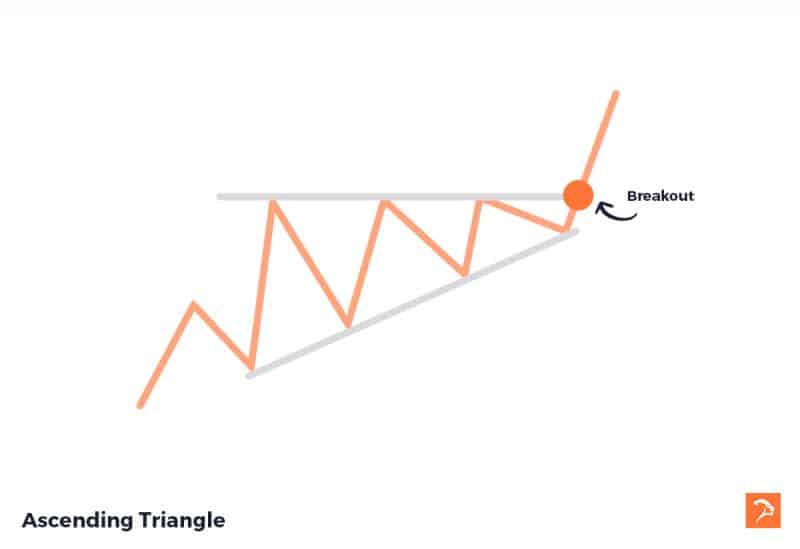
How to Trade Ascending Triangle Trading Patterns
Once price forms a solid uptrend towards a horizontal resistance level you can look for price to break out. Wait for confirmation of price breaking above the horizontal. The trend line should be near horizontal resistance, or toward the point of the triangle. This indicates the sellers losing control and the buyers gaining momentum.
Real Life Example of an Ascending Triangle Trading Pattern
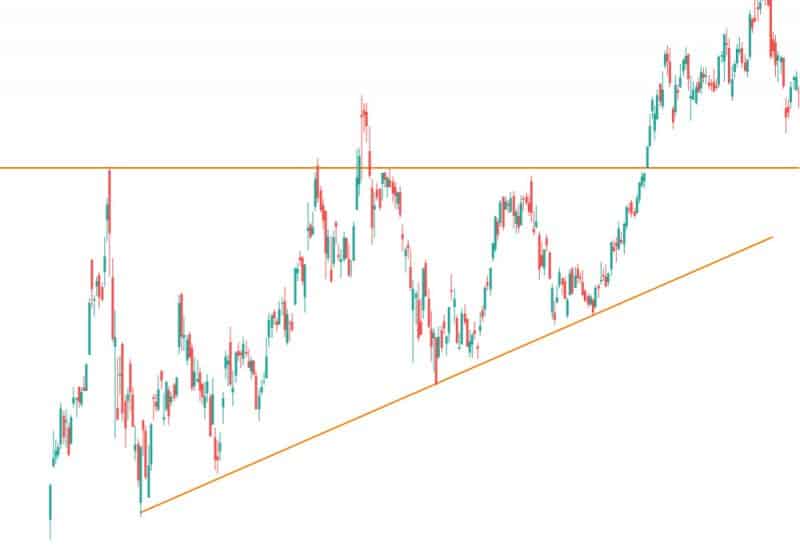
Bullish ABC Trading Patterns
A Bullish ABC Trading Pattern forms when the market is in an upward trend. This pattern is an example of symmetry in trading.
Price will move up from point A, to point B which is a higher high. B becomes a pivot as price reverses to point C.
The leg from A to B is a significant move, and the high of B creates a new resistance level.
The pivot point C needs to form a higher low than A for the ABC pattern to be valid. The higher low implies a general trend to the upside.
For the pattern to complete, price needs to reverse off C. Some traders choose to enter the trade when there is confirmation of that reversal, others will wait for resistance at point B to break.
This trade doesn’t complete every time, as no pattern does. However, if price is able to reverse and trend up, the move tends to be of a similar distance as the move from A to B
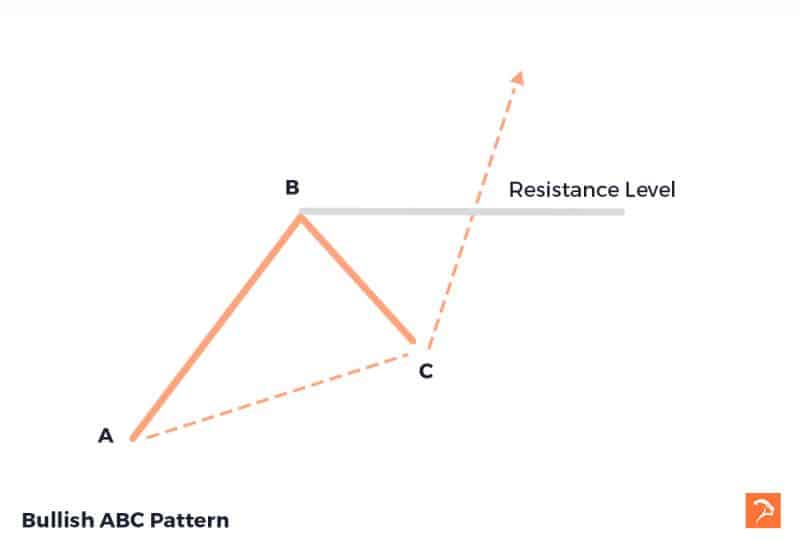
How to Trade Bullish ABC Trading Patterns
To trade a Bullish ABC pattern, wait for confirmation of a reversal at point C. Once you have a close of the first green candle reversing off C you have confirmation of the reversal.
You can enter the trade at this point and place your stop loss just below C as this is the support level.
Don’t enter the trade if there are any unrelated resistance levels, wait for those to be broken.
We know that the next major resistance level is point B in the pattern, you can choose this as your target or first of 2 targets.
The uptrend from C is often roughly the same size as the trend from A to B. You can use this information to find a larger target or a secondary target.
In the example below I chose to wait for some resistance (on the left) to clear before I entered. I miss part of the move but that’s ok, I want to make sure the pattern has a chance to complete.
I have decided to make the resistance at pivot B as my first target. I have copied the leg from A to B and used it to measure my second target.
When price reaches Target 1 (T1) I reduce my position by half and move my stop halfway to my T1 level. Note if I put my stop all the way up to T1 I would get stopped out and miss T2.
Price does eventually trend higher than the length of AB and I reach Target 2 and take profit on the remaining position.
Real Life Example of a Bullish ABC Pattern
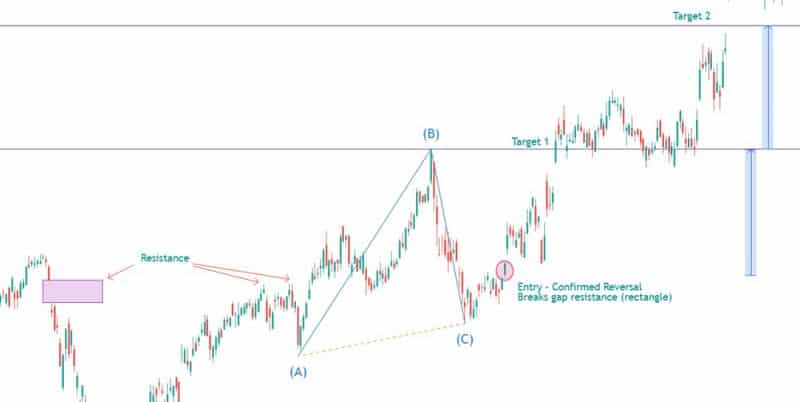
Bullish ABCD Trading Patterns
The Bullish ABCD chart pattern is similar to an ABC pattern in that it is a harmonic trading pattern.
Bullish ABCD trading patterns form when a down trend retraces up and then pulls back creating a second, equal downtrend. These trading graph pattern look like a “lightning bolt” trending downward.
There are 3 legs (AB, BC, CD), and 4 points (ABCD).
The first leg (AB) is drawn from point A to B in a strong downtrend. The second leg (BC) forms by a smaller retracement forming the C. The third leg (CD) then forms after a second strong downtrend of a similar size of AB.
When price hits point D it typically forms a strong uptrend reversal.
The points of resistance off the reversal are point B and C, and then finally point A.
When considering this trading pattern it is good to look at other technical indicators. A rally from A to B will have high volume, with the consolidation (BC) at a lower volume. The volume then increases again off the reversal of C, slows as it nears D and increases as the reversal begins to take shape off D.
Consolidation periods have lower volume and breakouts have higher volume. Knowing this can help confirm the pattern.
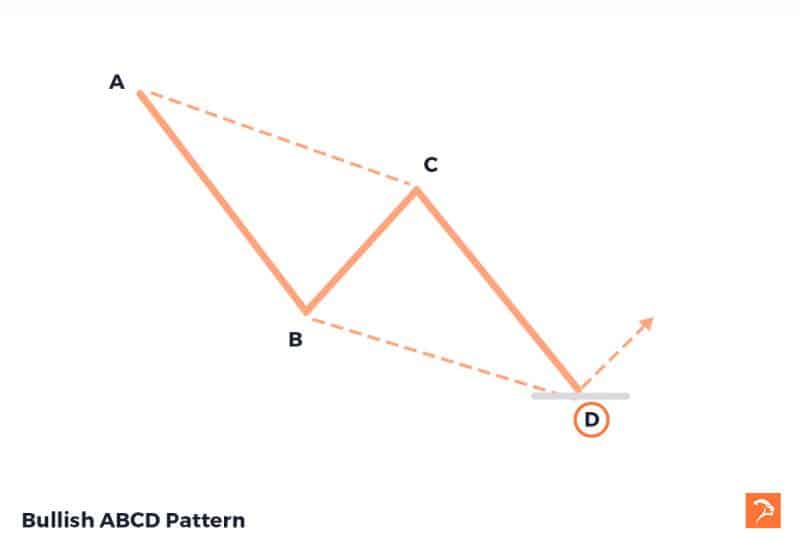
How to Trade Bullish ABCD Trading Patterns
To trade the Bullish ABCD trading pattern you need confirmation of the reversal off of point D. In the example below the confirmation comes at the close of the first candle to reverse off D.
The stop loss for the trade should be placed just below the low at D. You can choose to set a target at the resistance of C, or if you’re confident about the move, the resistance at A.
In the example below I have set a target at either B or C. I chose C where I take part profit, and move my stop halfway between entry and C.
Because this is another harmonious pattern, the trend up is often the same size as the first downtrend. For this reason, my second target is at point A.
In this case the pattern completes beautifully and both targets are reached.
Real Life Example of a Bullish ABCD Trading Pattern
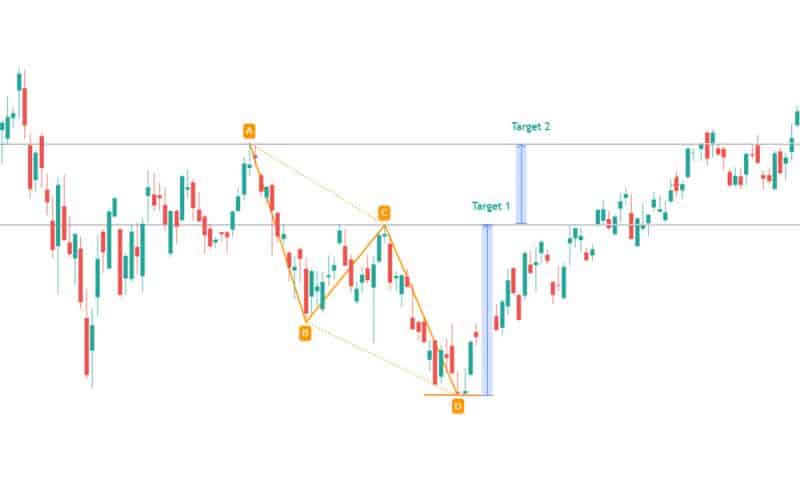
Bull Flag Trading Patterns
A Bull Flag is a fairly simple trading pattern. The pattern forms after a strong uptrend followed by a small pull-back, often a sign of profit taking.
The uptrend forms the pole of the flag, the pull-back forms the flag part of the pattern. The flag consists of a small downward rectangle formed by trendlines on the highs and lows. This looks like a flag on a pole.
A trader will wait for price to break resistance and breakout to the high-side.
There is symmetry in this trading pattern as well and the uptrend is often equal to the height of the flag pole.
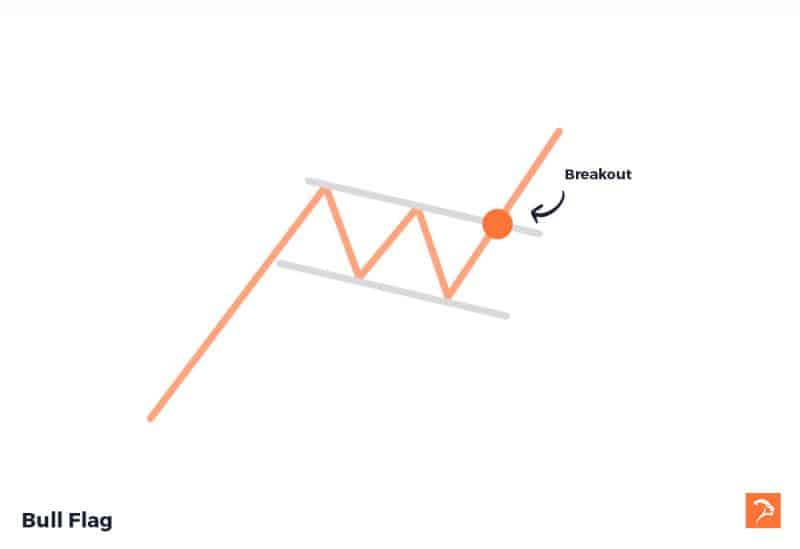
How to Trade Bull Flag Trading Patterns
First you need to establish that a flag is forming after a bullish uptrend. The flag will include a support level of lower lows, and a resistance level of lower highs.
Your entry is where price breaks above the resistance level. Your stop loss should go just below the support level of the flag.
In the example below I wait for the close of the candle that breaks resistance then enter. I place my first target at a 1:1 reward to risk, then target 2 the same distance above target 1. You’ll notice that my second target is roughly the same length as the flagpole.
This particular trade completes the pattern and hits target 2 after a little resistance just below the target.
Real Life Example of a Bull Flag Trading Pattern
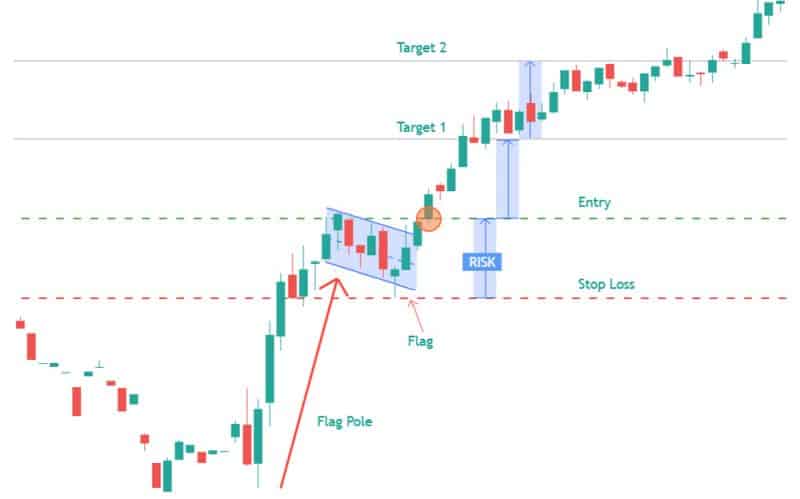
Bull Pennant Trading Patterns
A Bull Pennant pattern looks a bit like a Symmetrical Triangle, but there are some differences. Unlike a Symmetric Triangle, a Bull Pennant must form after a significant uptrend. A Bull Pennant also spends less time in consolidation, thus is smaller.
After a strong move, volume decreases inside of the Pennant, before increasing and breaking out to the upside. The decreasing volume forms converging trendlines.
This is an example of a continuation pattern. Often the uptrend after a breakout is roughly the same as the trend prior to the pennant shape.
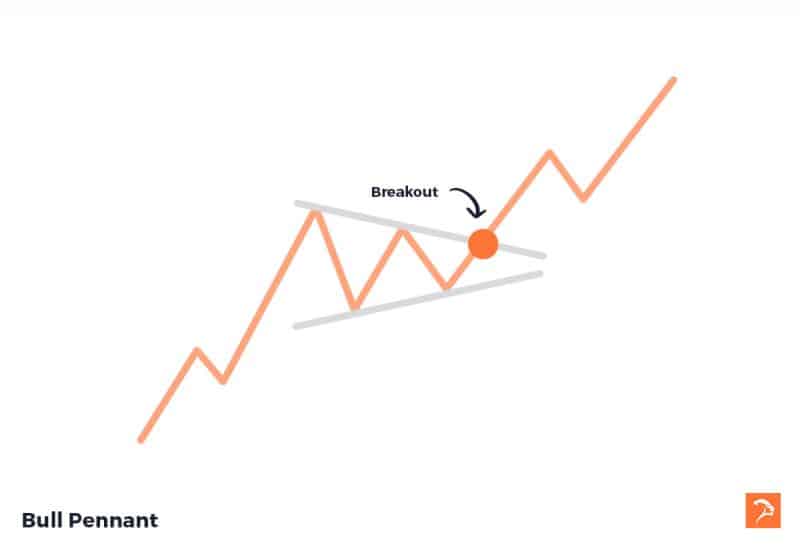
How to Trade Bull Pennant Day Trading Patterns
You trade a Bull Pennant in a similar way to a Bull Flag. After a bullish run up you will wait for the pennant shape to form. There will be a series of lower highs and higher lows. Volume decreases as the pennant forms.
Your entry point will come as volume increases and there is confirmation of a break out of resistance. Normally where the trend lines close in on each other.
In the example below I miss part of the move as I wait for the close of the candle that breaks resistance. I’m fine with this because I want to be sure that I don’t get stuck in a false breakout.
Your stop should be placed where support was first tested in the pennant. In the example below, my stop is just below the pennant shape.
My first target is 1:1 on my risk, my second target is equal price from target 1. You’ll notice that the distance from my entry to my second target is roughly the same as the flagpole.
The pattern starts seeing resistance right along my target, but it does get triggered. The outcome is a nice reward to risk and a big move.
Real Life Example of a Bull Pennant Trading Pattern
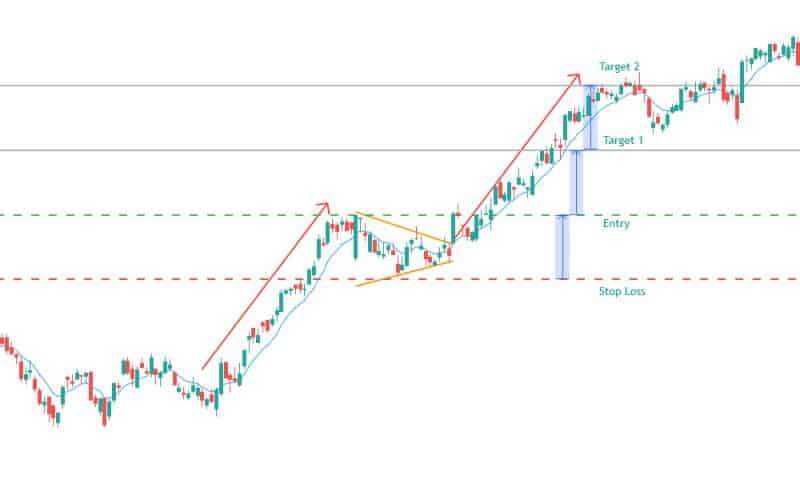
Falling Wedge Trading Patterns
Wedges are like pennants, drawn using two converging trendlines. The difference is that the trend lines at support are downward.
A Falling Wedge chart pattern forms when support and resistance slant toward each other in a downward direction.
This is a bullish day trading pattern, suggesting price will break resistance levels. The breakout tends to occur when support and resistance become narrow. The concept is very similar to the Bull Pennant.
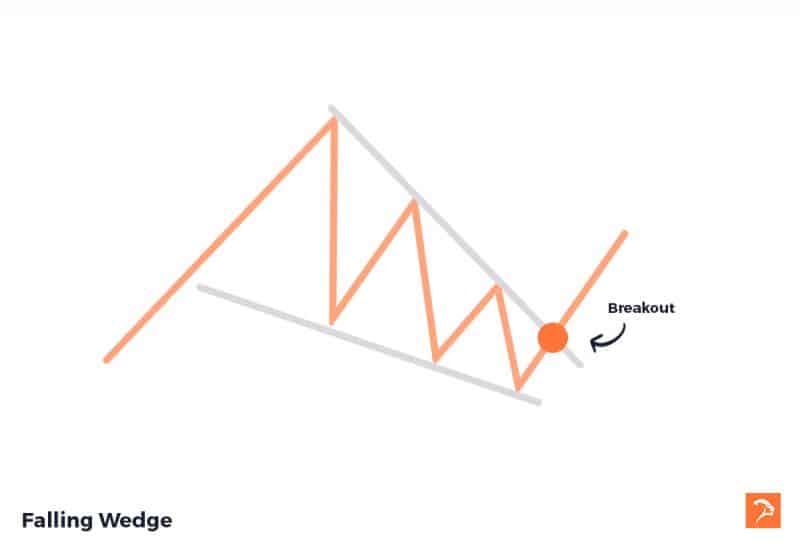
How to Trade Falling Wedge Trading Patterns
You will identify a potential falling wedge chart pattern when a large uptrend stalls, then trends down. The downward trend will contain a support level of lower lows. There will be a resistance level formed by lower highs.
These two trend lines will begin to merge toward each other in a wedge shape. The entry will be found when there is confirmation of the breakout of the resistance level.
In the example below I enter after confirmation and place my stop just below the most recent support of the wedge.
I have put my first target at the top of the wedge where there is resistance, just slightly less than 1:1 reward to risk.
My second target is set at a distance equal to the size of the flagpole away from where price broke.
The pattern completes and the result is a reward to risk with a large move.
Real Life Example of a Falling Wedge Trading Pattern
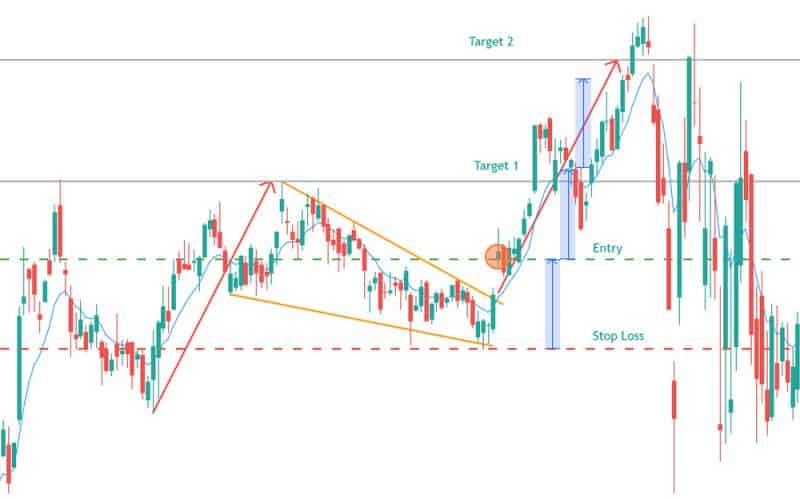
Inverted Head and Shoulders Trading Patterns
The Inverted Head and Shoulders trading pattern consists of two shoulders, a head, and a neckline. The bullish variant is an Inverted Head and Shoulders pattern.
This trading pattern forms 3 troughs, 2 are the shoulders and 1 is the head. Each of the shoulders in the pattern are of equal or similar size, the head is a larger trough.
The head of the trading pattern occurs in between the two shoulders forming what looks like a head on top of 2 shoulders.
Each shoulder pulls back to similar levels before and after the head has formed. This is what creates the neckline of the trading pattern.
An Inverted Head and Shoulders pattern predicts that a large downtrend is going to reverse into a large uptrend.
The neckline serves as the resistance level. Once a breakout of this level occurs, price typically gains momentum to the high side.
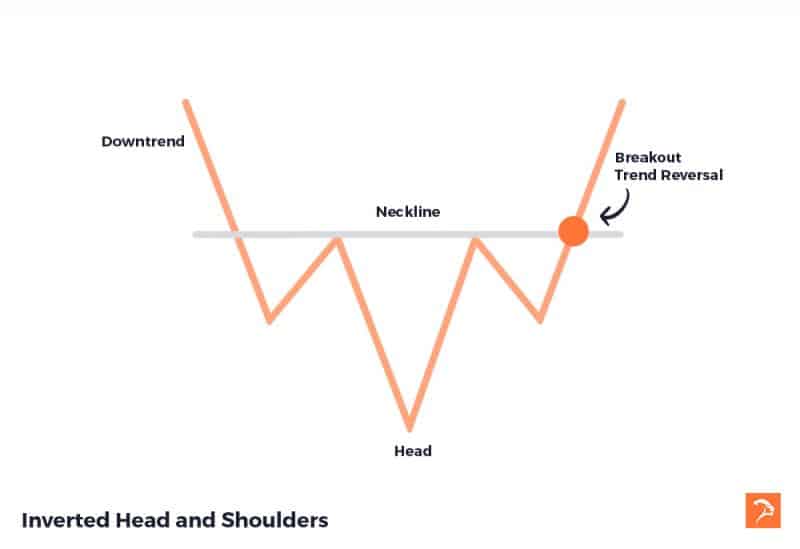
How to Trade Inverted Head and Shoulders Trading Patterns
Your entry level should be the confirmation of a breakout of the neckline. This means you enter the trade when the neckline has been broken and the candle closes.
This will be a buy trade, with the stop placed at the right shoulder as the failure point. Set your target at 1:1 risk to reward or better.
Real Life Example of an Inverted Head and Shoulders Pattern
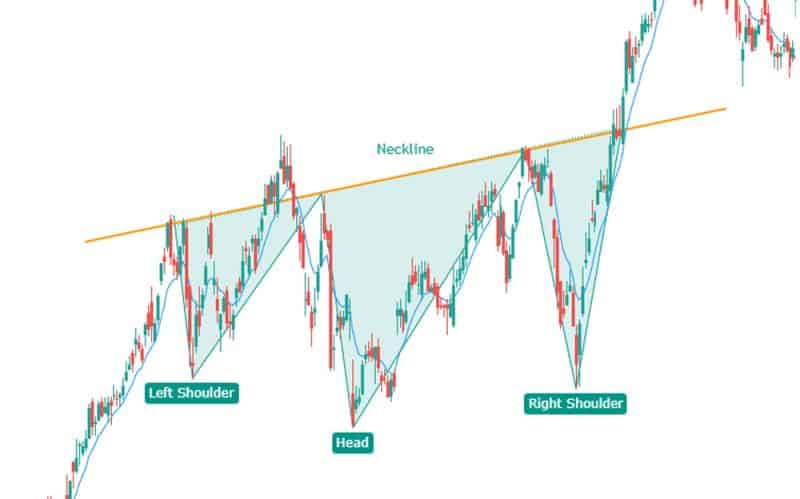
Double Bottom Trading Patterns
A Double Bottom chart pattern forms when two lows form at the same level. A downtrend will reverse off of a level, then fail, reverse back down to the same level. When price fails to break the first bottom, it creates the second bottom. The second bottom creates a support level.
The pattern forms after a downtrend and completes on a reversal of the second bottom making a W shape. The high reached in the middle of the W becomes a resistance level.
When the resistance level has broken, there is confirmation of the reversal off bottom 2. This will lead to a large uptrend often of a similar size to the downtrend before the pattern forms.
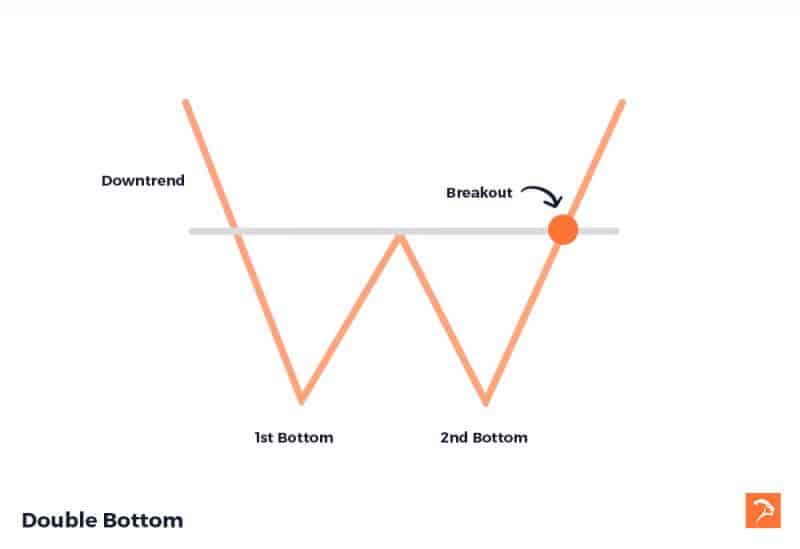
How to Trade Double Bottom Trading Patterns
When price hits the same low for a second time and reverses you can wait for a breakout. When price moves beyond resistance it has broken out. This is a buy on the confirmation of the breakout.
A stop should be placed on or below the 2 lows as a failure point. Look to have your target at a minimum of a 1:1 reward to risk.
Alternatively, you can choose to trade off the confirmation of the reversal off the second bottom. Here you would likely set your target at the neckline as the resistance point.
Real Life Example of a Double Bottom trading Pattern
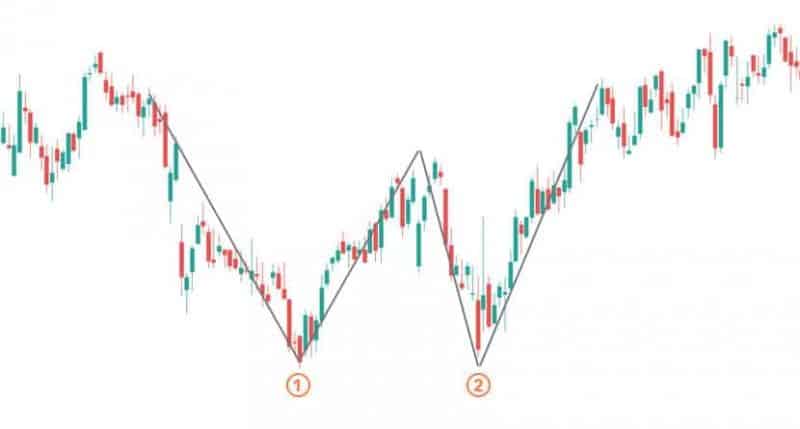
Triple Bottom Trading Patterns
A Triple Bottom trading pattern is like a double bottom, but with one more reversal off of the support level. A Triple Bottom is a stronger pattern than the double bottom as it continues to hold support. This means that the support level is strong.
The Triple Top also has a “neckline” resistance level. When price has broken this level the trade is a “breakout”
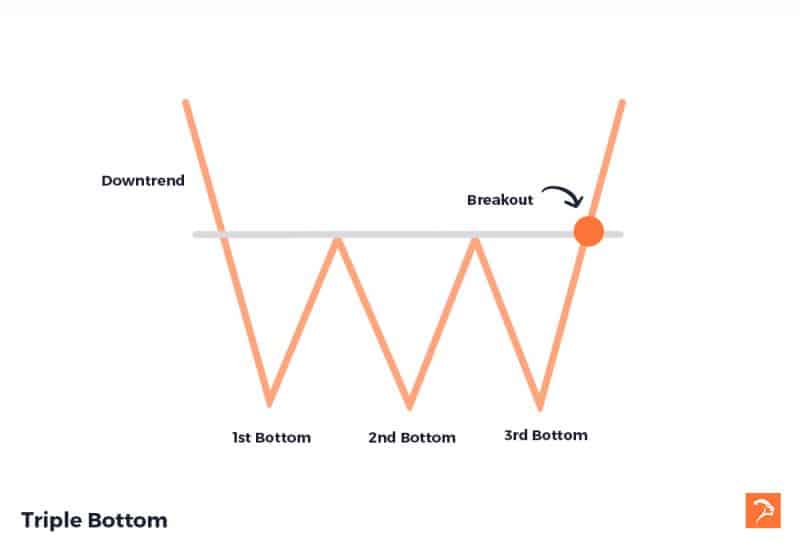
How to Trade Triple Bottom Trading Patterns
You would trade a Triple Bottom chart pattern in the same way you would a double bottom. The idea is the same, however you should have more confidence in the support level because it is stronger.
Wait for confirmation of a breakout of the neckline after the third bottom before entering. Stop loss on or below the lows as a failure point. Look to have your target at a minimum of a 1:1 reward to risk.
Alternatively, you can choose to trade off the confirmation of the reversal off the third bottom. Here you would likely set your target at the neckline as the resistance point.
Real Life Example of a Triple Bottom Trading Pattern
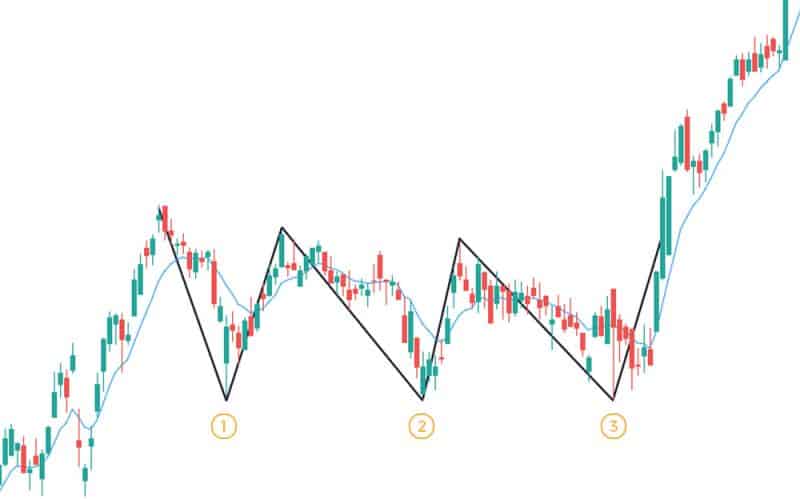
Rounding Bottom Trading Patterns
A rounding bottom chart pattern forms when a downtrend slows into sideways movement before forming an uptrend. Price forms a semi-circle like shape.
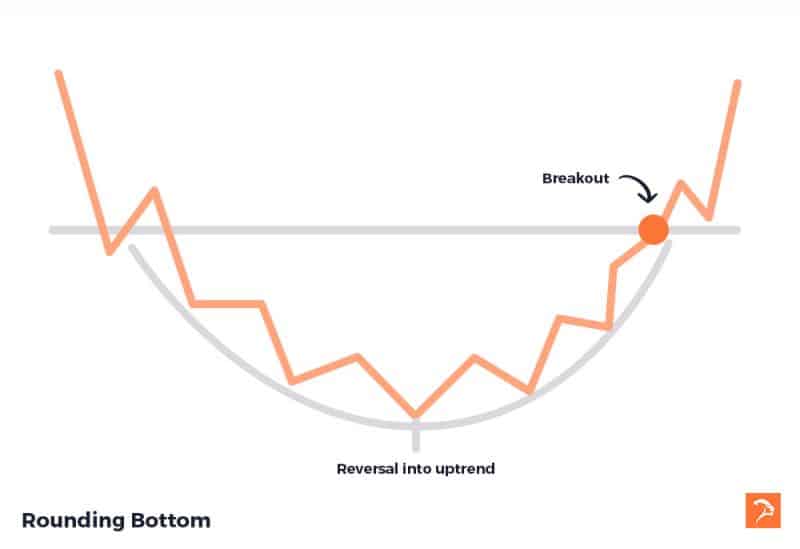
How to Trade Rounding Bottom Trading Patterns
You can trade this pattern in two ways. You can choose to enter as seller volume decreases and buy volume increases. This would indicate that price is beginning to reverse into an uptrend.
Alternatively, you can wait for price to break out of the high formed at the start of the pattern.
Real Life Example of a Rounding Bottom Trading Pattern
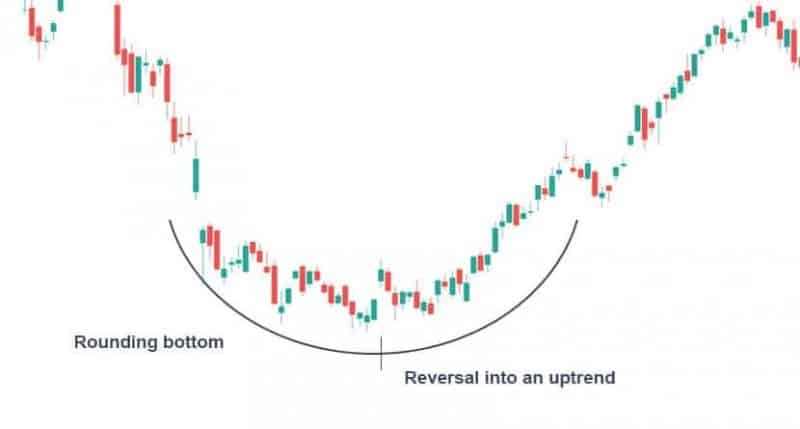
Cup and Handle Trading Patterns
A Cup and Handle chart pattern is an extension of a rounding bottom. After the completion of the rounding bottom there is a short-lived downtrend. The rounding bottom is the “cup” of the pattern and the downtrend is the “handle”.
This pattern suggests that there might be an uptrend when price breaks above the top of the cup.
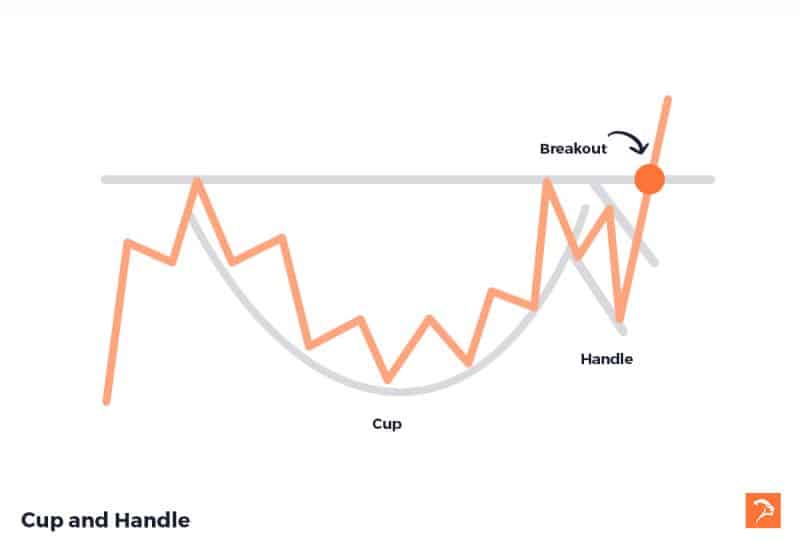
How to Trade Cup and Handle Trading Patterns
Once a rounding bottom has completed, wait for a small pull back. The lower lows and lower highs create the support and resistance (handle).
You can choose to enter the trade at the breakout of the handle, or the top of the cup. Entering at the top of the cup is further confirmation of the breakout. Your stop loss should be just below the low of the handle.
Set your target at least a 1:1 reward to risk from the stop loss level. If there is a volume spike at the breakout you can look to increase that target.
Real Life Example of a Cup and Handle Trading Pattern
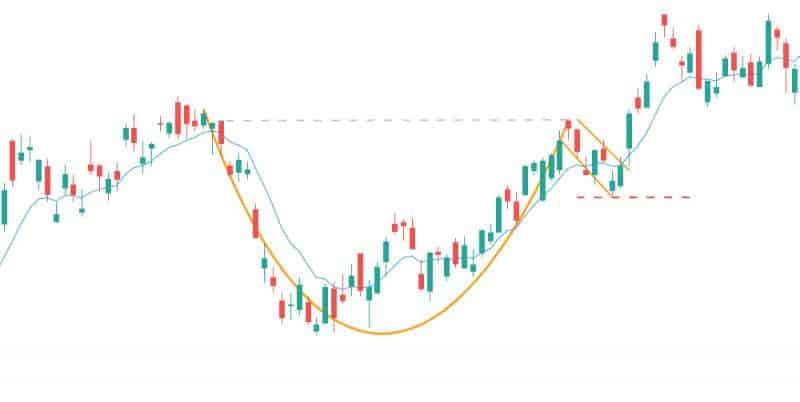
Bearish Trading Patterns
If you are someone who buys and sells stocks you won’t have access to trade bearish trading patterns. These patterns seek to make profit off of price falling and require short selling.
Traders who trade the following should in most cases be able to short the market:
Futures, Options, CFDs, Forex
Descending Channel Trading Patterns
As it is with Ascending Channels, a Descending channel trading pattern is a type of continuation. The overall sentiment is bearish and price forms lower highs and lower lows. These lower highs and lower lows create support and resistance levels.
While the pattern remains intact, these levels will see price reverse off of them.
What makes this pattern bearish is that each time a new high, or low forms, it is at a lower price than the previous.
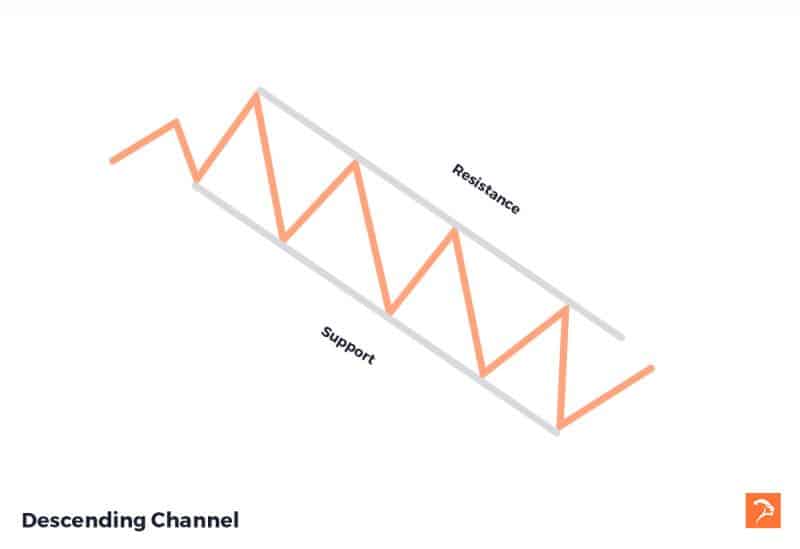
How to Trade Descending Channel Trading Patterns
A Descending Channel is a sell trade and is traded in a similar but opposite way as an Ascending Channel.
Look to enter off of a reversal of a resistance level. It’s important to not trade into support or resistance. For a big channel you can choose to sell off a reversal of resistance and buy back at support.
Alternatively, you can choose to hold that position until resistance is broken. This means that you capture a large amount of the downtrend.
Real Life Example of a Descending Channel Trading Pattern
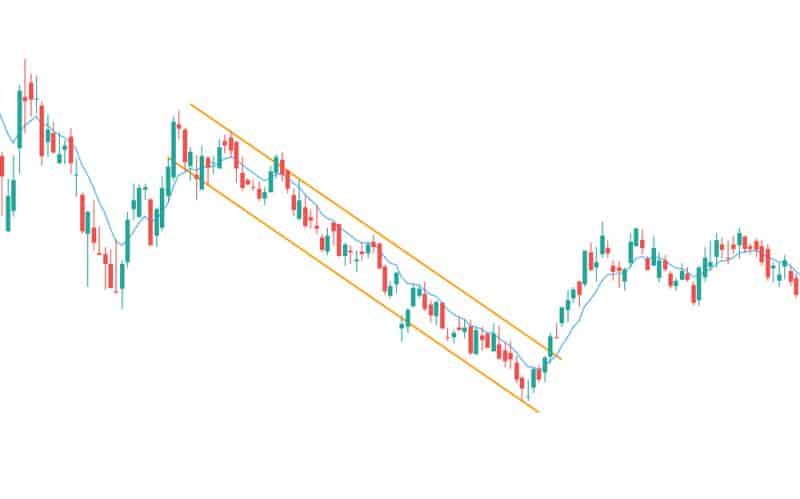
Descending Triangle Trading Patterns
A Descending Triangle chart pattern forms when a downtrend approaches a major support level. This support level is a price point that has proven difficult to break below.
A Descending Triangle is an example of a continuation pattern. In this trading pattern the downward trend forms as lower highs are reached.
You can draw a Descending Triangle using a support level and trendline down. Place a horizontal line along the lows (support), and then draw a trend line along the highs (resistance).
The trading pattern has at least 2 lows at the same level, this forms the horizontal line. The lower highs form the trend line that completes the triangle.
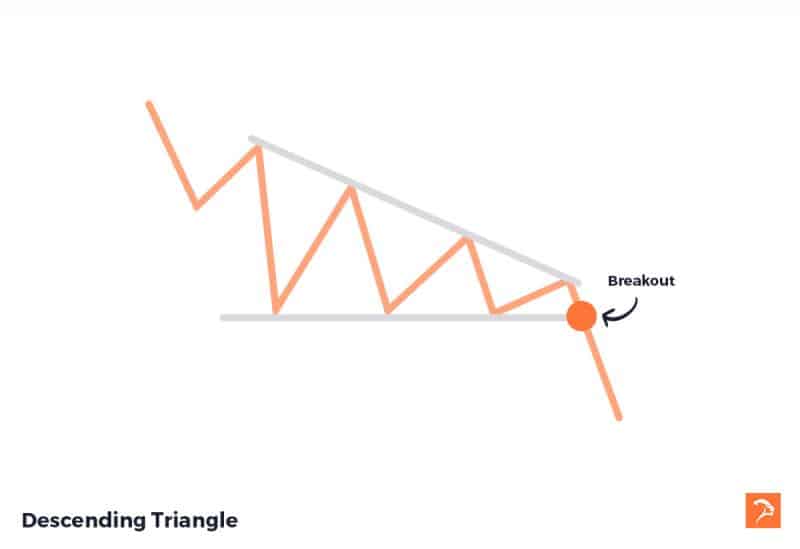
How to Trade Descending Triangle Trading Patterns
A Descending Triangle tells us that there is stronger selling pressure than buying. The highs are becoming lower and lower while support holds.
Once support breaks there is typically high seller volume and a downtrend begins.
Enter the trade at the breakout placing your stop loss just above the last point of resistance. Typically, your target will be your entry price minus the height of the triangle (depending on the size of the triangle). You can see this with the red arrows in the example below.
The targets are adjusted in the trade below because the entry was off a big candle. Each target is 1:1 and is easily reached.
Real Life Example of a Descending Triangle Trading Pattern
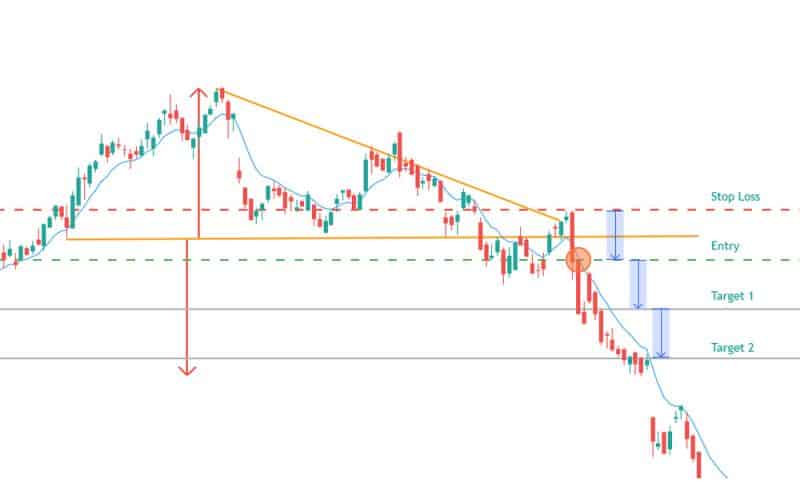
Bearish ABC Trading Patterns
A Bearish ABC trading pattern forms when the market is in a downtrend.
Price will move down from A to B, then reverse off B creating a support level. This level will be a lower low compared with A.
The pivot point C needs to form a lower high than that of A for the ABC pattern to be valid. The lower high implies a general trend to the downside (weakening of buyers).
For the pattern to complete, price needs to reverse off C. Some traders choose to enter the trade when there is confirmation of that reversal, others will wait for support at point B to break.
This trade doesn’t complete every time, as no pattern does. However, if price is able to reverse and trend up, the move tends to be of a similar distance as the move from A to B. As with the Bullish variant of this pattern, a Bearish ABC trading pattern is often symmetrical.
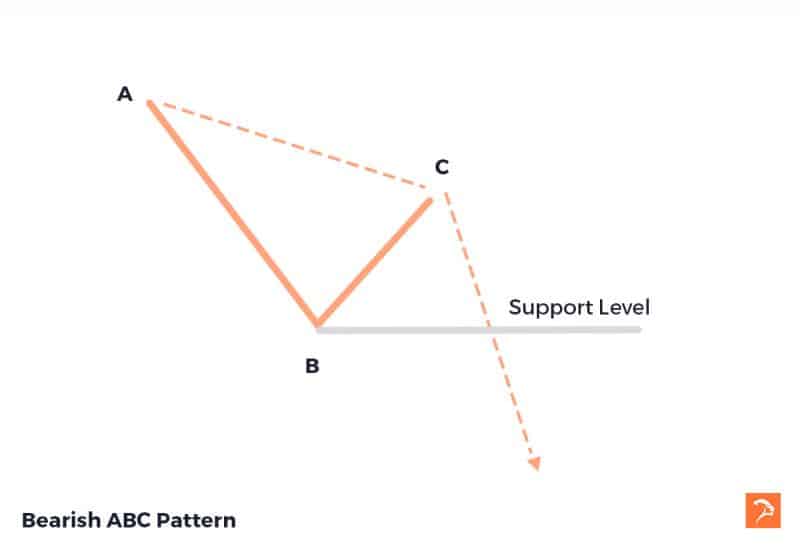
How to Trade Bearish ABC Trading Patterns
As with a bullish ABC pattern, you enter the trade when price reverses at the c pivot point, once there is confirmation. Don’t enter the trade if there are any resistance levels, wait for those to be broken.
I set my entry point to be the close of the first candle that breaks the horizontal support.
I’ve set the stop loss at the close of the candle that reversed off of the failed breakout. I don’t want to put my stop right on point C, I want a bit of breathing room.
In the example below I have decided to make the resistance at pivot B as my first target as it is the first point of strong resistance. For the second target I add the same distance after target 1.
At target 1 I reduce my position by half and move my stop to my entry level. At target 2 I have a take profit set and take my remaining profits.
Real Life Example of a Bearish ABC Trading Pattern
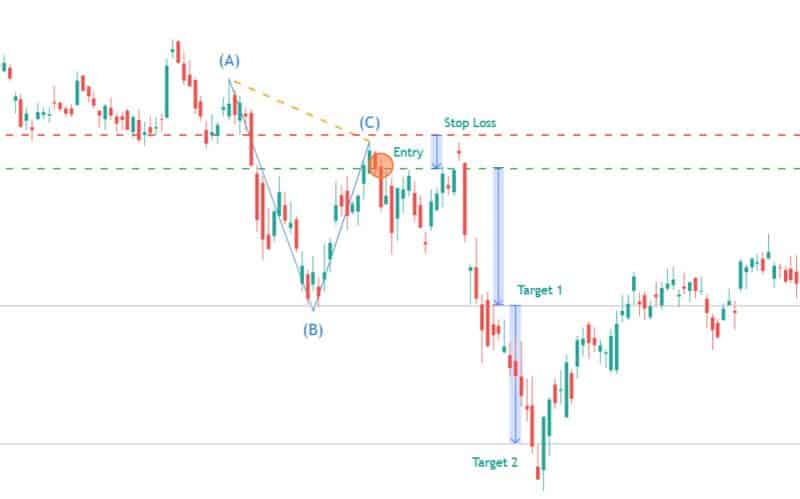
Bearish ABCD Trading Patterns
The Bearish ABCD chart pattern is another example of symmetry in the markets.
This bearish trading pattern begins with an uptrend from A to B. Price then has a smaller retracement at B to C. Finally, there is a reversal off C creating a second, equal uptrend. The trading pattern looks like a “lightning bolt” trending upward.
When price hits D it typically begins a strong reversal. Support levels are now at B, C, and A.
When considering this trading pattern it’s good to look at other technical indicators. A rally from A to B will have high volume, with the consolidation (BC) at a lower volume. The volume then increases again off the reversal of C, slows as it nears D and increases as the reversal begins to take shape off D.
Consolidation periods have lower volume and breakouts have higher volume. Knowing this can help confirm the pattern.
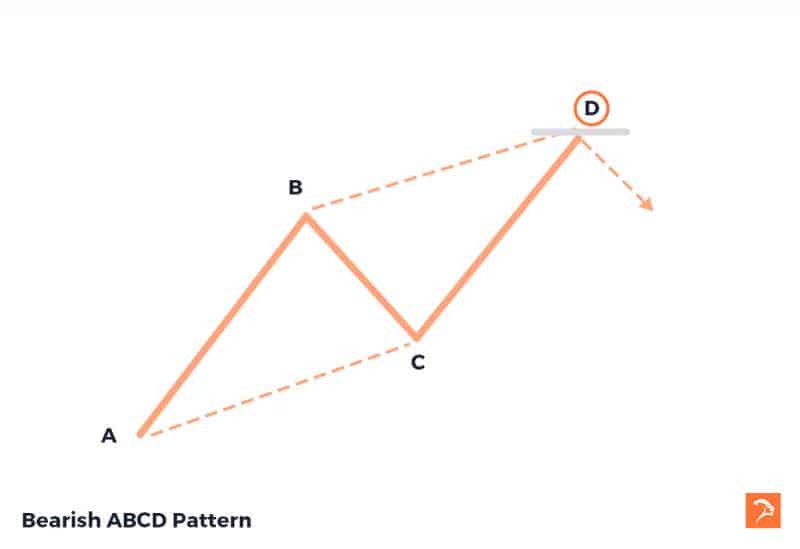
How to Trade Bearish ABCD Trading Patterns
To trade a Bearish ABCD you need confirmation of the reversal off of point D. In the example below the confirmation comes at the close of the first candle to reverse off D.
The stop loss for the trade should be placed just above the high at D. You can choose to set a target at the resistance of B, or C. If you’re confident about the move, you could set the target at the resistance level of A.
In the example below I have set a target at B where I take part profit, then another at C. In this example I move my stop halfway to my first target and get stopped out despite price going on to reach target 2.
If I leave the stop where it is, the pattern completes beautifully and both targets are reached. Price eventually breaks the resistance at A and continues to fall.
Real Life Example of a Bearish ABCD Trading Pattern
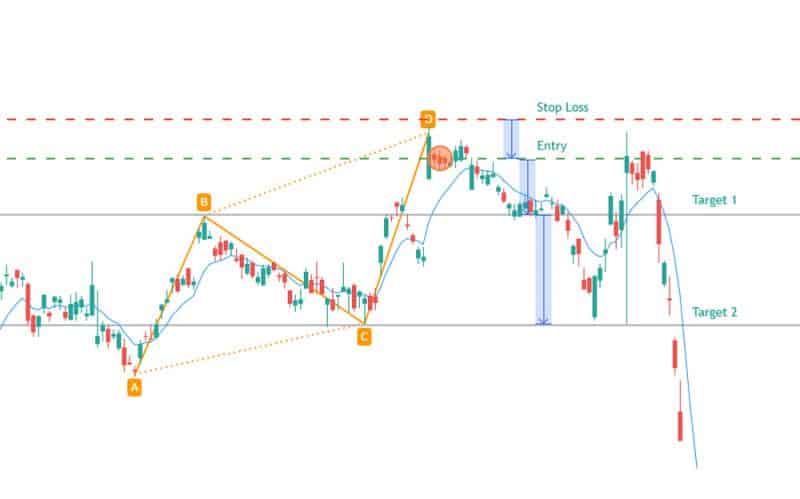
Bear Flag Trading Patterns
A Bear Flag chart pattern forms after a strong downtrend followed by a small pull-back to the upside. The downtrend forms the pole of the flag, the pull-back forms the flag part of the pattern. The flag consists of a small upward rectangle formed by trendlines on the highs and lows. This forms what looks like a flag on a pole.
A trader will wait for price to break resistance and breakout to the low-side.
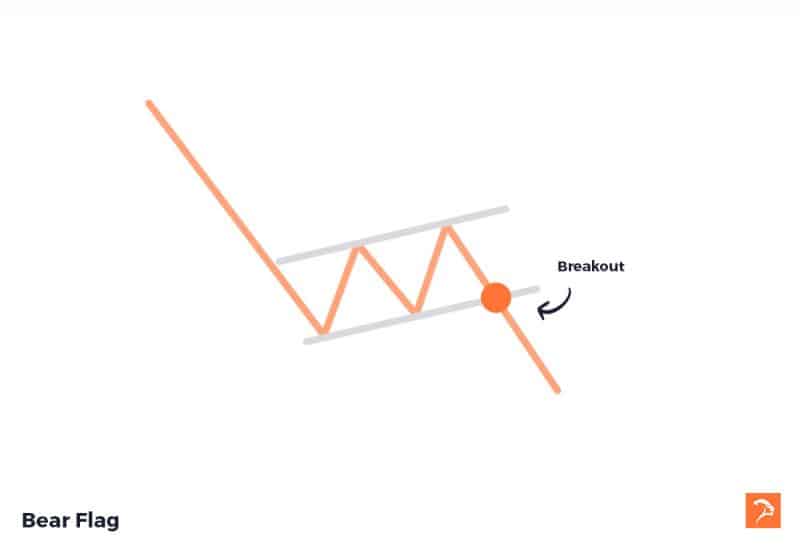
How to Trade Bear Flag Trading Patterns
Like with a Bullish Flag, you need to confirm a flag is forming. The flag forms after a strong downtrend. The flag will include a support level of higher lows, and a resistance level of higher highs.
Your entry is where price breaks below the support level. Your stop loss should go just above the resistance level of the flag.
In the example below I wait for the close of the candle that breaks support then enter. I place my first target at a 1:1 reward to risk. Target 2 will be the height of the flag pole from my entry.
This particular trade completes the pattern (only just!) and hits target 2 before trading back up.
Real Life Example of a Bear Flag Trading Pattern
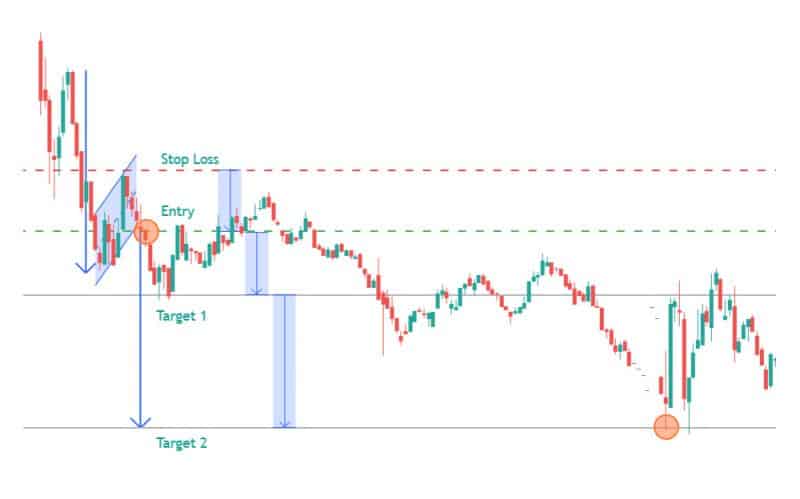
Bear Pennant Trading Patterns
A Bear Pennant trading pattern may look like a Symmetrical Triangle, but there are some differences. Unlike a Symmetric Triangle, a Bear Pennant forms after a significant downtrend. A Bear Pennant also spends less time in consolidation and is therefore smaller.
After a strong move, volume decreases inside of the Pennant, before breaking out to the downside with high seller volume. The decreasing volume forms converging trendlines.
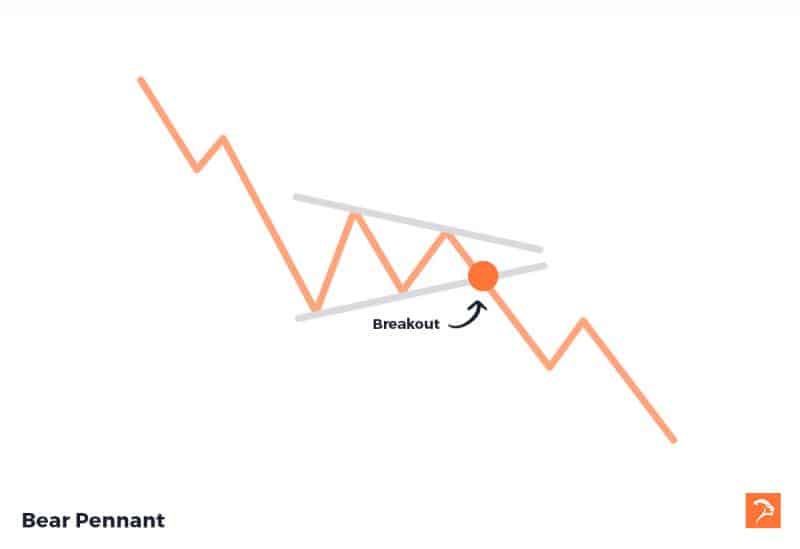
How to Trade Bear Pennant Trading Patterns
You trade a Bear Pennant in a similar way to a Bear Flag. After a strong downtrend you wait for the pennant shape to form. There will be a series of higher highs and lower lows.
Volume typically decreases as the pennant forms which is what helps form the shape.
Your entry point will come as volume increases and there is confirmation of a break out of support. Normally at the point of the pennant where the trend lines almost meet.
In the example below I miss part of the move as the candle that breaks support is very big.
Your stop should be placed where resistance was first tested in the pennant. In the example below, my stop is just above the pennant shape.
My target is roughly the same as the flag pole from my entry. Volume is big, as are the candles, so I’m happy to have one target at the full length of the flagpole.
The pattern starts seeing resistance right along my target. My target triggers right before the support level forms and price reverses.
The outcome is a nice, better than 3:1 reward to risk
Real Life Example of a Bear Pennant Trading Pattern
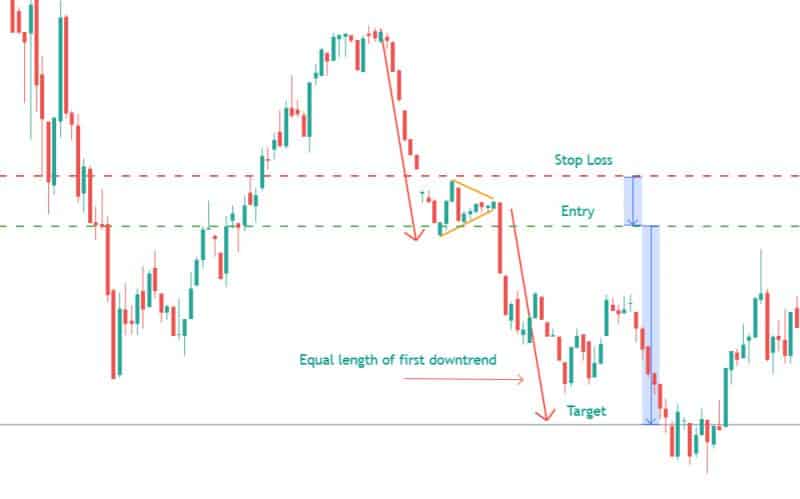
Rising Wedge Trading Patterns
A Rising Wedge chart pattern forms when support and resistance slant toward each in an upward direction.
This is a bearish day trading pattern which suggests price will break support levels. The breakout tends to occur when support and resistance become narrow.
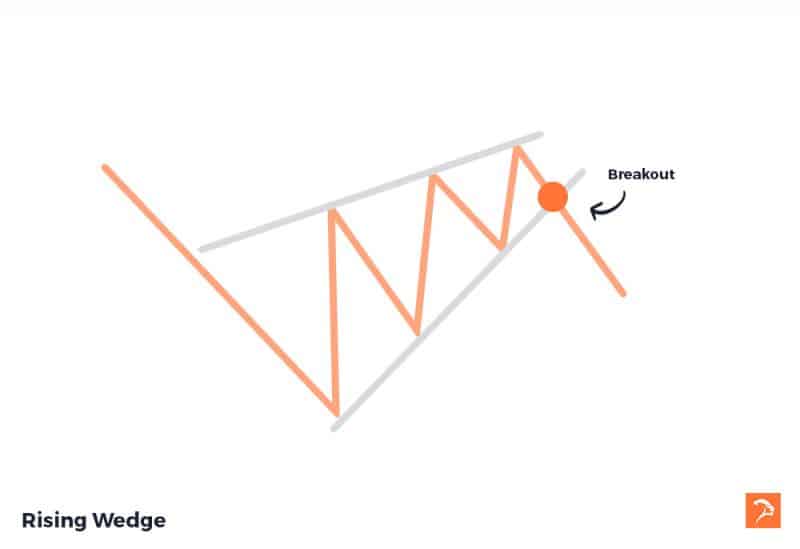
How to Trade Rising Wedge Trading Patterns
A Rising Wedge trading pattern forms off the reversal of a downtrend. The uptrend will have higher lows and higher highs. These levels form support and resistance.
These two trend lines will begin to merge toward each other in a “wedge” shape. The entry will be found when there is confirmation of the breakout of the support level.
In the example below I enter after confirmation and place my stop just above the most recent resistance level of the wedge.
I have put my first target at the first support level of the wedge shape. This happens to make the first target a 1:1 reward to risk.
My second target is set equal distance as the first. In retrospect I could have been more ambitious and looked to place the second target at the length of the flag pole. No complaints with how the trade went, both targets reached.
Something to notice in the example below. The buyer volume is decreasing as the wedge tightens. The seller volume begins to increase as the breakout occurs. The strong seller volume is further confirmation of the breakout.
Real Life Example of a Rising Wedge Trading Pattern
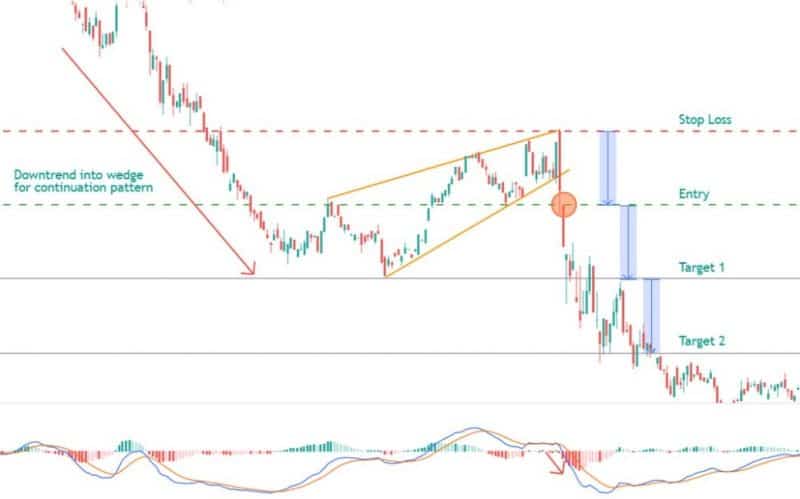
Head and Shoulders Trading Patterns
The Head and Shoulders trading pattern consists of two shoulders, a head, and a neckline. The bearish variant forms when 2 smaller uptrends, and 1 larger uptrend reverse.
The first reversal makes the left shoulder, the second, larger one forms the head, the final reversal is the right shoulder. The 2 shoulders in this pattern are at roughly the same price.
The reversal points between shoulder and head occur at the same level which form a neckline. The neckline serves as the support level. Once a breakout of this level occurs, price typically gains momentum to the downside.
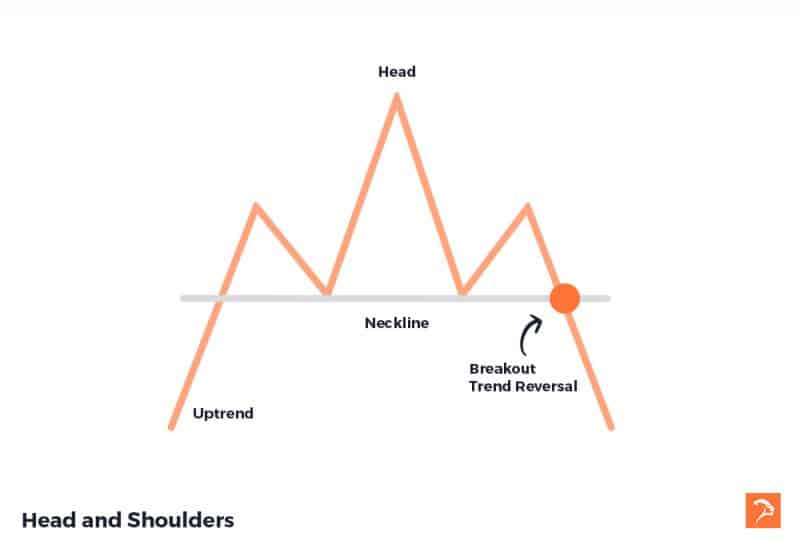
How to Trade Head and Shoulders Trading Patterns
Your entry level should be the confirmation of a breakout. This means you enter the trade when the neckline has been broken. This will be a sell trade, with the stop placed at the right shoulder as the failure point. Set your target at 1:1 risk to reward or better.
Real Life Example of a Head and Shoulders Pattern
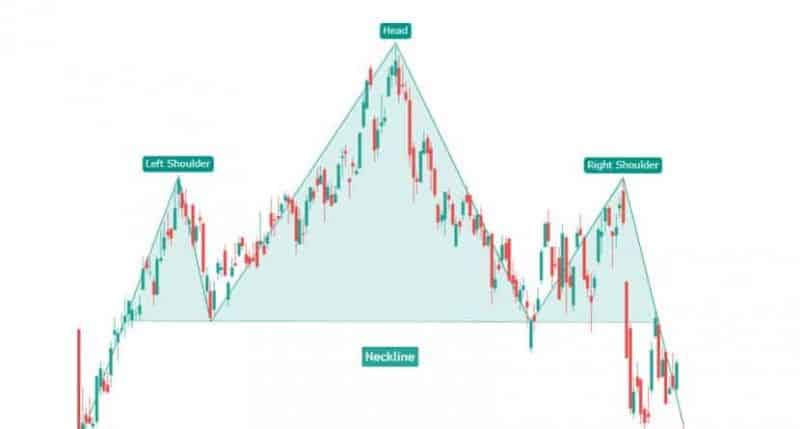
Double Top Trading Patterns
Double Top chart patterns form when two highs form at the same level.
An uptrend will reverse off of a level, then fail, reverse back up to the same level and reverse once more. When price fails to break the same level more than once, this creates support.
The pattern forms as 2 highs with a low in-between making a M shape. The low reached in the middle of the M becomes a resistance level.
When the resistance level has broken, there is confirmation of the reversal off top number 2. This will lead to a large downtrend often of a similar size to the uptrend before the pattern forms.
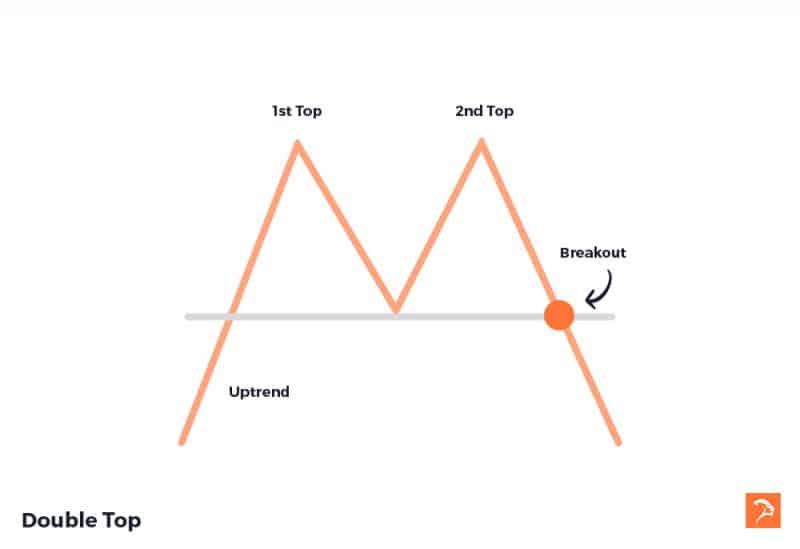
How to Trade Double Top Trading Patterns
When price hits the same high for a second time and reverses, wait for a breakout. When price moves beyond the neckline (low point in between highs) it has broken out. This is a sell on the confirmation of the breakout.
Stop loss on or above the highs as a failure point. Look to have your target at a minimum of a 1:1 reward to risk.
Alternatively, you can choose to trade off the confirmation of the reversal off the second bottom. Here you would likely set your target at the neckline as the resistance point.
Real Life Example of a Double Top Trading Pattern
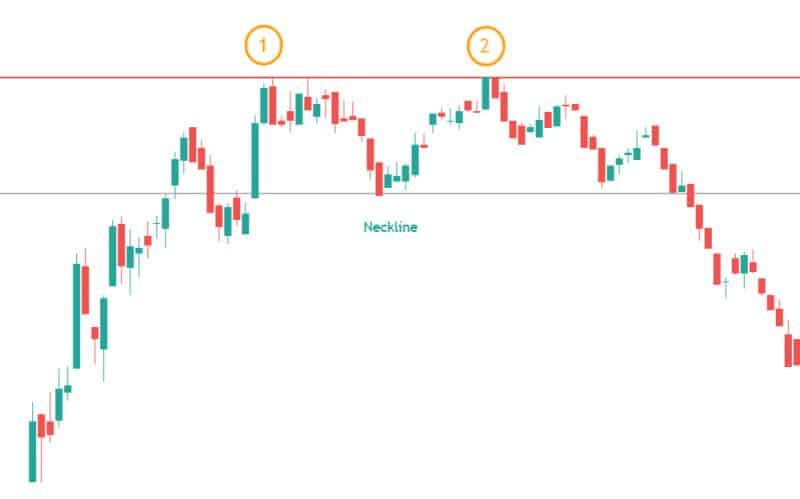
Triple Top Trading Patterns
A Triple Top chart pattern is like a double top, but with one more reversal off of the resistance level. A Triple Top is a stronger pattern than the Double Top as it continues to hold resistance. This means that the resistance level is strong.
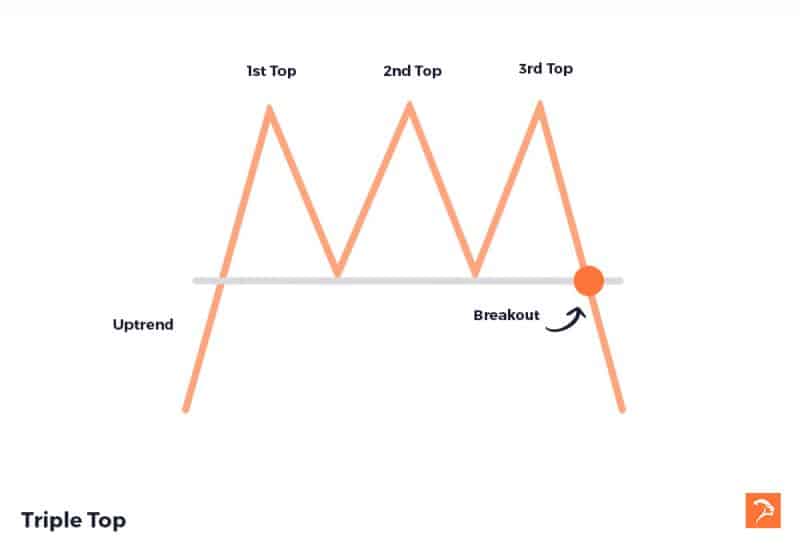
How to Trade Triple Top Trading Patterns
You would trade a Triple Top trading pattern in the same way you would a Double Top. The idea is the same, however you should have more confidence in the resistance level because it is stronger.
Wait for confirmation of a breakout of the neckline after the third top before entering. Stop loss on or above the highs as a failure point. Look to have your target at a minimum of a 1:1 reward to risk.
Alternatively, you can choose to trade off the confirmation of the reversal off the third top. Here you would likely set your target at the neckline as the resistance point.
Real Life Example of a Triple Top Trading Pattern
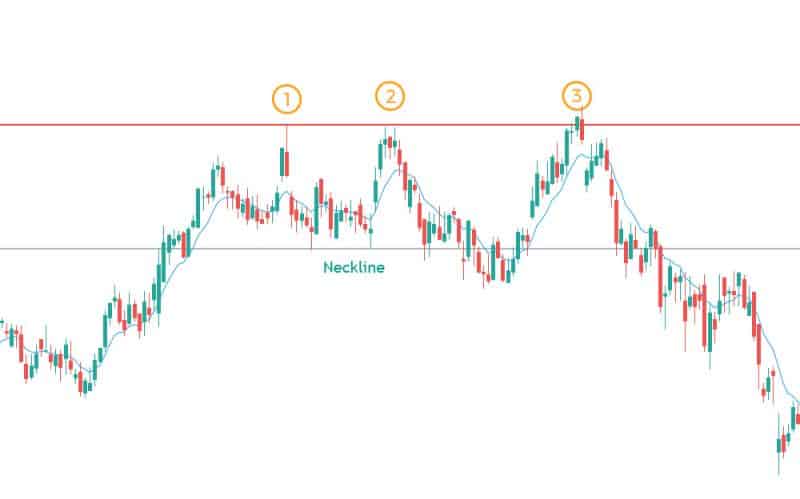
Rounding Top Trading Patterns
A rounding top chart pattern forms when an uptrend slows into sideways movement before forming a downtrend. Price forms an upside-down semi-circle like shape. A trader will look to sell near the top, when the downtrend is starting to form. Alternatively, you could trade the breakout at the bottom of the semi-circle.
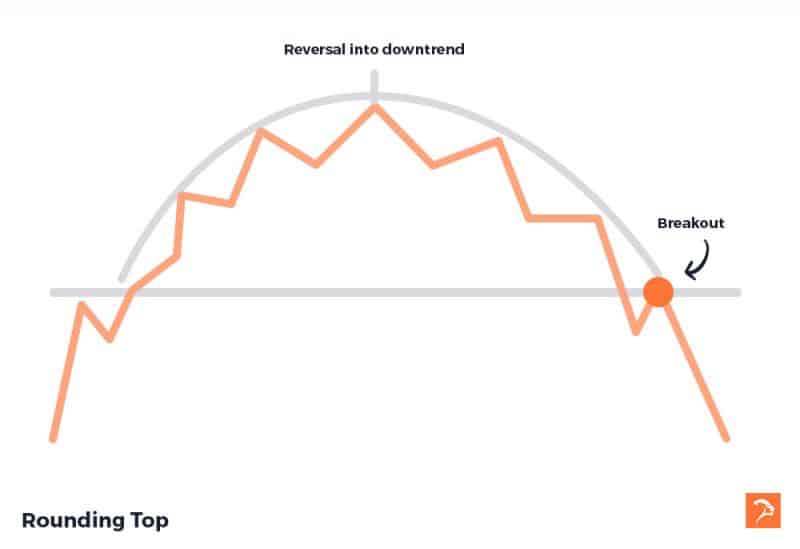
How to Trade Rounding Top Trading Patterns
You can trade a Rounding Top chart pattern in two ways. You can choose to enter on the reversal to a downtrend if there is weak buyer volume. Alternatively, you can wait for price to break out of the low formed at the start of the pattern.
Real Life Example of a Rounding Top Trading Pattern
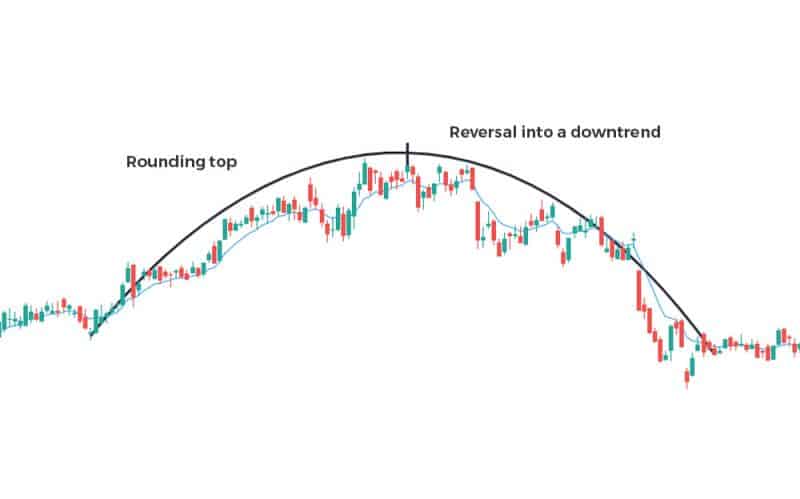
Inverted Cup and Handle Trading Patterns
An Inverted Cup and Handle chart pattern is a bearish variant of the Cup and Handle, it is also a continuation pattern. After a Rounding Top there is a slight pullback to the high-side before a continuation to the low-side. The Rounding Top forms the (upside down) “Cup” and the flag shaped pullback forms the “Handle” of the pattern.
At the completion of the handle there is a chance of a breakout to the low-side creating new lows.
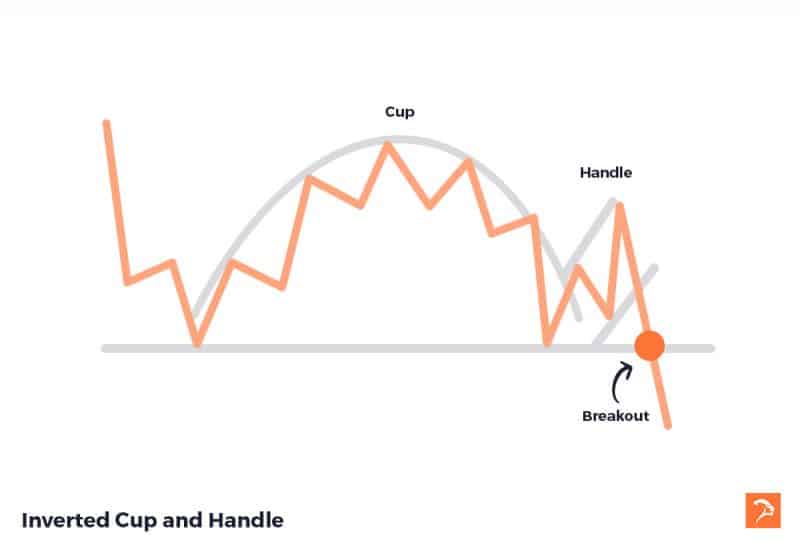
How to Trade Inverted Cup and Handle Trading Patterns
Once a Rounding Top has completed, wait for a small reversal to the upside. The higher lows and higher highs create the support and resistance (handle).
You can choose to enter the trade at the breakout of the handle, or the top of the cup. Your stop loss should be just below the low of the handle.
Set your target at least a 1:1 reward to risk from the stop loss level. If there is a volume spike at the breakout you can look to increase that target.
Real Life Example of a Inverted Cup and Handle Trading Pattern
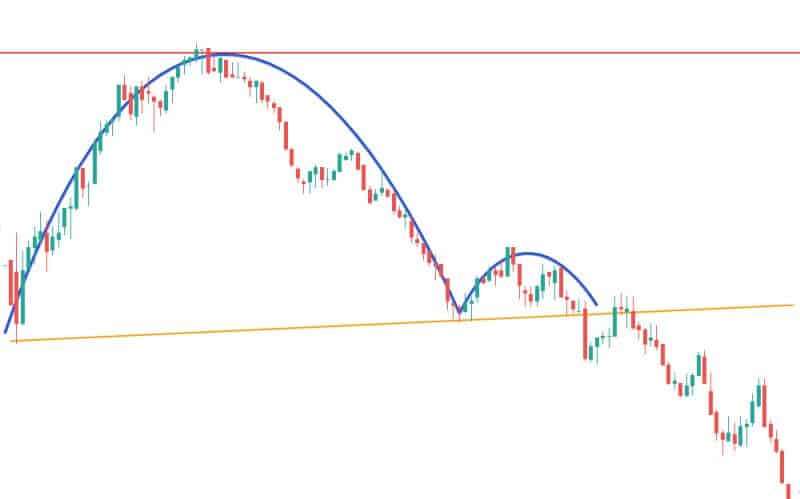
Day Trading Patterns
Any of the above can be considered Day Trading Patterns as well as swing trading patterns. The most popular types of Day Trading Patterns are momentum/breakout patterns, or reversal chart patterns. For day traders the best type of pattern is the one that provides the most movement. Trading chart patterns used for day trading are less likely to be simple channels as they are less volatile and provide a smaller amount of movement.
Trading Patterns Cheat Sheet
The below trading patterns cheat sheet contains all of the candlestick chart patterns discussed above. Save this or print it out for reference next time you sit down to trade. The trading pattern cheat sheet is broken down into type of pattern and whether the sentiment is bullish or bearish. Consider a trader course for a more in-depth understanding of these patterns.
Trading Patterns: The Bottom Line
With these trading patterns you have a set of tools to find high-probability trades. These trading chart patterns do fail at times, but complete more often than not. Because probability works in the long term, you should statistically come out on top.
It is important to not only use these day trading patterns to find trades, but also practice day trading risk management. If you are not managing these trades correctly then the statistics don’t matter.
Keep your winners equal to, but preferably larger than your losers. Limit your risk in each by using a stop loss trading. Finally set your targets and stop losses that are appropriate to your risk tolerance and trading plan.
If you want to learn more about the International Day Trading Academy’s own day trading strategy you can join us for our next free day trading web class

